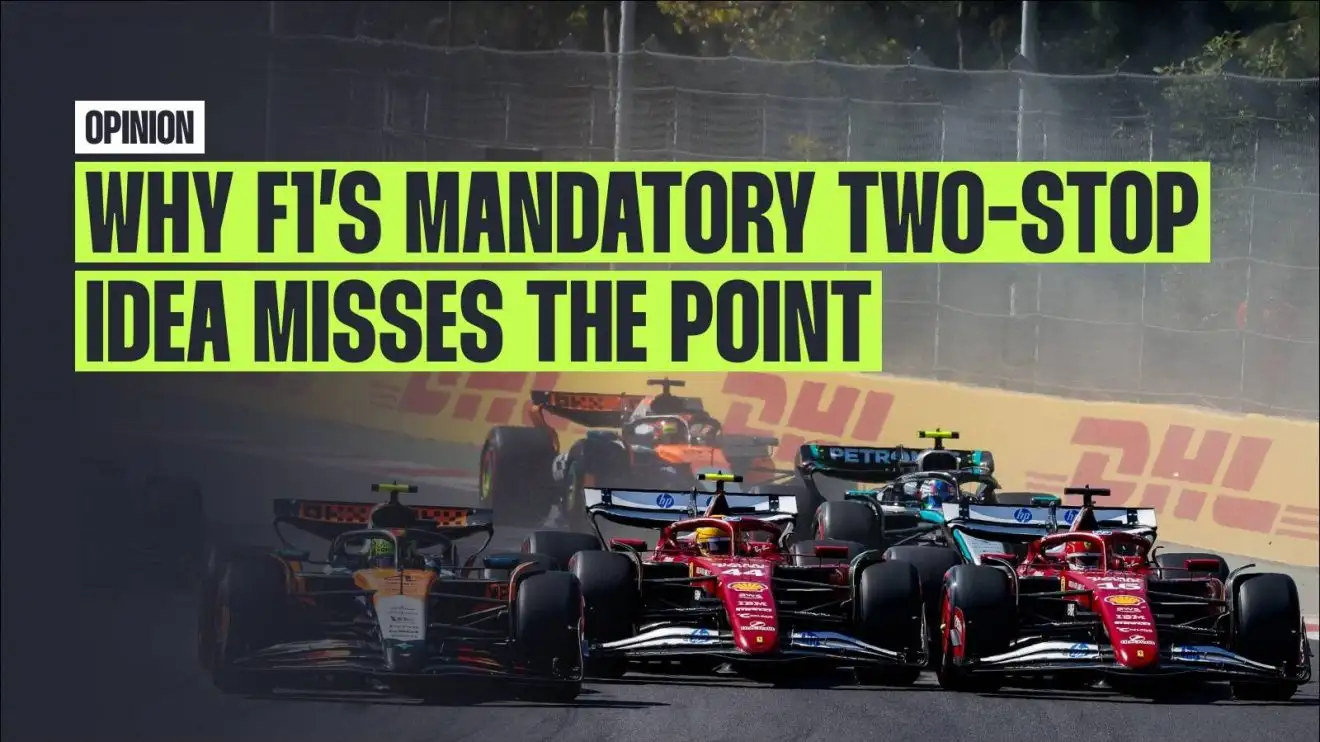From engineering to entertainment: Why F1’s mandatory two-stop idea misses the point

Discussions to consider mandating a minimum of two pitstops per race are a band-aid on a bigger issue.
Discussions about an idea to introduce a mandatory two stops to Formula 1 are tentatively being held, but shouldn’t the sport be looking in the other direction?
It has been confirmed to PlanetF1.com that the concept of introducing a rule to ensure a mandatory two-stop strategy is to be discussed at the F1 Commission, with an eye to introducing further strategic options.
Why is a mandatory two-stop strategy being discussed?
With slow pitlane speed limits, teams are loath to pit their cars any more than is necessary, meaning that, where track conditions and tyre life makes it possible, a single pit-stop is frequently the winning strategy in modern F1; indeed, the most recent five races have all been won with a single-stop strategy.
This year, the idea of introducing a mandatory two-stop strategy was introduced at the Monaco Grand Prix in a bid to head off a predictable processional race.
The logic was somewhat understandable, but the reality was that teams in advantageous positions were able to use their second cars to slow the pack up in order to create gaps to make their stops.
While the concept was largely met with negativity, but the idea of expanding the rule to create a mandatory two-stop requirement is being mooted.
As it stands, the requirement to use two compounds during a grand prix means a pitstop is effectively mandated.
But with strategic options rarely allowing for much by way of variety, the imposition of a required second stop is being considered.
The logical idea would be that this would ensure the teams are forced to use all three supplied compounds for a grand prix weekend during the race, and attempt to add some further opportunities for things to go wrong for teams by way of slow stops and pit errors, but does little to back away from the increasing feeling of artificiality that has crept into the sport in the modern era.
A fundamental factor which makes this idea less palatable is that it takes away one of the few remaining areas of variability that can decide the outcome of a grand prix, although even this variability has been reduced in recent years due to the longevity of Pirelli’s medium-to-hard compound tyres.
While once a sport that was primarily an engineering display, meaning huge gulfs in performance between teams were possible, and normal, the successful commercialisation of the sport into the arena of entertainment and show business means that the regulations have become so tightly prescribed that the performance disparity between the fastest and slowest teams is now miniscule in terms of percentage.
This can even be seen in the recently-announced ADUO regulations for power unit manufacturers for F1 2026.
While those who nail the new regulations can enjoy a brief reward of a period of dominance, the stragglers will be awarded greater opportunities to develop their engines and close that gap; this will ensure greater performance parity across the board.
While not a spec-series, F1 has been continuously moving in a direction that closes in on that descriptor.
But in a sport where the performance differentiators have become so slim, strategic gambles can still provide plenty of entertainment when the conditions and tyres allow for the possibility.
A mandatory two-stop strategy would likely only worsen this, rather than improve it.
After all, Pirelli’s Mario Isola has already explained that, when the teams were privately asked to predict strategies based on three selected compounds for a race weekend, the majority of the teams still converged upon the same strategy.
“They were basically replicating the same strategy,” he said.
“So when you put more constraints, the risk is that everyone is going in the same direction.”
Given that enforcing an extra stop is merely an extra constraint, how would this step mean anything but underlining Isola’s point correct?
Rather than having a predictable one-stop where everyone largely does the same thing, it would merely be a predictable two-stop where everyone largely does the same thing.
After all, given the proven longevity of the Pirelli compounds, drivers would, essentially, be pitting simply to conform to an arbitrary rule rather than actually requiring a stop due to their tyres being at the end of their life.
Look at the Mexico Grand Prix, where Lando Norris raced his soft tyres for 34 laps, half of the race, without issue, having set off on those tyres while his car was at its heaviest.
Or at Monaco, where Verstappen made it to the penultimate lap of the race hopeful of a red flag, with everyone watching aware that he needed to pit again – for no reason other than to fulfil a regulatory requirement, rather than his tyres being finished.
If the tyres aren’t reaching the limits of their performance envelope, there would be a logical ‘pro’ to the idea: the tyres, as currently constructed and homogenised for 2026, would never degrade in the length of a stint during what would be a ‘normal’ two-stop strategy, meaning, like at Qatar in 2023, the drivers could push without the tyres being a limiting factor.
However, without refuelling, management of fuel and overall car and tyre temperatures would still be a factor, meaning the dreaded ‘lift and coast’ would not disappear.
At present, aside from a few hot and abrasive circuits, the low degradation Pirellis mean that certain compounds on any given weekend will always be the favoured ones, and low degradation means the tyre offset isn’t large enough to encourage strategic gambles, meaning a continuation of quite predictable strategy choices.
If there is a desire to mix the tyre rules up (which, with my cynic’s hat on, is also of great commercial value to Pirelli, given that the tyres would therefore be a continuous topic of conversation during a race weekend) and introduce greater strategic variance, the idea surely should be to not increase a greater number of mandatory pitstops, but to tackle the tyre themselves and, maybe, even remove any sort of mandated compound use at all.
An idea could this be to vastly reduce the tyre life of the compounds in order to ensure greater tyre offsets, and make it far more uncertain as to whether a one-stop, with significant management, is faster than a two-stop without, while ensuring that the harder compounds can comfortably do 90 per cent of the race, and perhaps 100 per cent with a little (but not too much!) consideration.
With a soft tyre, like in Mexico, capable of completing half of the race without issue, it shows that the compounds’ longevity is simply too great.
It’s almost 30 years since F1 had a driver finish in the points without making a pitstop, with Mika Salo at Monaco in 1997 being the most recent to do so.
Given the proven longevity of harder compound tyres, why not free up the tyre usage rules to allow drivers to take gambles like this?
Imagine the possibilities: Max Verstappen leading out front on hard compound tyres attempting to make a non-stop work, Oscar Piastri closing in on mediums on the one-stop strategy, and Lando Norris further back on a two-stop strategy, all without any mandates as to what compounds they needed to run.
Until Pirelli has tweaked the compounds in terms of performance and longevity to make it such that all three options are, in a straightforward race, roughly equal, then attempting to regulate further variables into the mix is not much different to oft-maligned Bernie Ecclestone idea of introducing sprinklers for manufactured chaos.
Primarily, F1 has always been about attempting to get from Point A to Point B in the quickest time possible and the teams should be given the freedom to attempt that by any means necessary without being forced into making pitstops that they simply do not need.
In a sport that edges further and further away from its roots of rewarding engineering brilliance and leans into the ‘entertainment’ provided by the chaos and unpredictability of teams lacking preparedness by way of reduction of practice and the introduction of sprint races, attempting to further neuter the elements of strategy that could make F1 an enthralling chess game are little more than slapping on a band-aid without fixing the injury.
Read Next: 30 years on: The full story of Mika Hakkinen’s life-threatening crash in Adelaide





